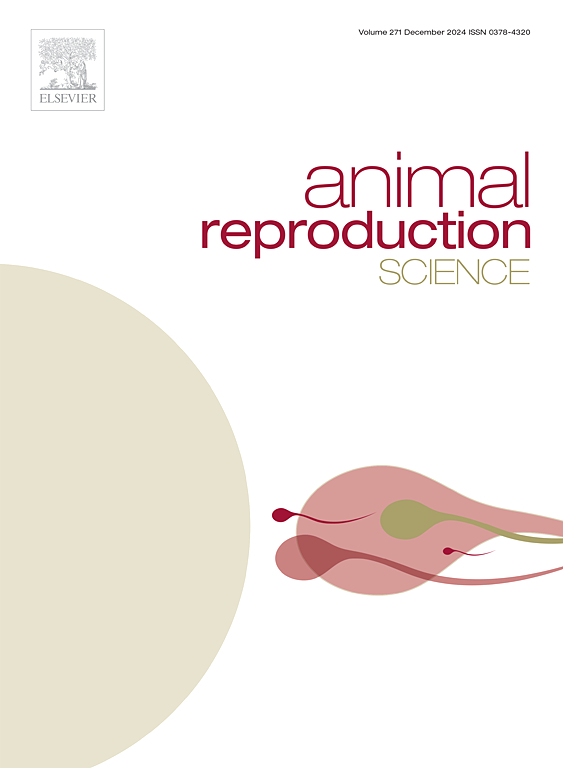牛子宫内膜免疫细胞的分布与产后受孕天数的关系
IF 2.2
2区 农林科学
Q1 AGRICULTURE, DAIRY & ANIMAL SCIENCE
引用次数: 0
摘要
在奶牛中,产后子宫炎症的消退过程与随后泌乳期生育能力的提高密切相关。然而,人们对着床前子宫内膜免疫细胞群的作用和分布知之甚少。本研究旨在分析健康奶牛在产后过渡时期以外的子宫内膜分布的几种单核免疫细胞(T 细胞、γδ T 细胞、B 细胞和巨噬细胞),寻找其与分娩-受孕间隔(PCI)和受孕延迟的可能关系。免疫组织化学(IHC)评估了免疫细胞的数量,双重 IHC 评估了免疫细胞中激素受体的表达。奶牛根据PCI分组:PCI短于或等于90 DIM(PCI≤90),PCI介于90和120 DIM之间(PCI90-120),PCI大于150 DIM(PCI≥150)。用广义线性模型分析了子宫内膜单核免疫细胞的分布,并用 Kaplan-Meier 检验评估了单核免疫细胞分布与受孕延迟的关系。与PCI≤90组相比,PCI90-120组奶牛的子宫内膜巨噬细胞数量最多,B细胞数量较少。结果还显示,着床前子宫内膜中 B 细胞数量较少与受孕时间提前之间存在关联。此外,本研究结果还表明,ESR 和 PR 在子宫内膜 MØ、T 细胞、γδ T 细胞和 B 细胞中均有表达。本文章由计算机程序翻译,如有差异,请以英文原文为准。
Endometrial distribution of bovine immune cells in relation to days to conception after parturition
In dairy cows, the processes involved in the resolution of uterine inflammation during the postpartum are closely related to improved fertility during the subsequent lactation period. Little is known, however, about the role and distribution of endometrial immune cell populations during the pre-implantation period. This study was aimed to analyze the endometrial distribution of several mononuclear immune cells (T cells, γδ T cells, B cells and macrophages) in healthy dairy cows during the postpartum, beyond the transition period, looking for its possible association with the parturition-conception interval (PCI) and delayed conception. The quantification of immune cells was evaluated by immunohistochemistry (IHC), and the expression of hormone receptors in immune cells was evaluated by double IHC. Dairy cows were grouped according to their PCI: PCI shorter than or equal to 90 DIM (PCI≤90), PCI between 90 and 120 DIM (PCI90–120), and PCI greater than 150 DIM (PCI≥150). The distribution of endometrial mononuclear immune cells was analyzed by a Generalized Linear Model, and the association of the distribution of mononuclear immune cells with delayed conception was evaluated with a Kaplan-Meier test. The cows from the PCI90–120 group showed the highest number of endometrial macrophages, and a lower number of B cells than the PCI≤90 group. Results also showed an association between the lower number of B cells in the endometrium during the pre-implantation period and earlier conception. Also, the present findings indicates that ESR and PR are expressed in the endometrial MØ, T cells, γδ T cells and B cells.
求助全文
通过发布文献求助,成功后即可免费获取论文全文。
去求助
来源期刊

Animal Reproduction Science
农林科学-奶制品与动物科学
CiteScore
4.50
自引率
9.10%
发文量
136
审稿时长
54 days
期刊介绍:
Animal Reproduction Science publishes results from studies relating to reproduction and fertility in animals. This includes both fundamental research and applied studies, including management practices that increase our understanding of the biology and manipulation of reproduction. Manuscripts should go into depth in the mechanisms involved in the research reported, rather than a give a mere description of findings. The focus is on animals that are useful to humans including food- and fibre-producing; companion/recreational; captive; and endangered species including zoo animals, but excluding laboratory animals unless the results of the study provide new information that impacts the basic understanding of the biology or manipulation of reproduction.
The journal''s scope includes the study of reproductive physiology and endocrinology, reproductive cycles, natural and artificial control of reproduction, preservation and use of gametes and embryos, pregnancy and parturition, infertility and sterility, diagnostic and therapeutic techniques.
The Editorial Board of Animal Reproduction Science has decided not to publish papers in which there is an exclusive examination of the in vitro development of oocytes and embryos; however, there will be consideration of papers that include in vitro studies where the source of the oocytes and/or development of the embryos beyond the blastocyst stage is part of the experimental design.
 求助内容:
求助内容: 应助结果提醒方式:
应助结果提醒方式:


